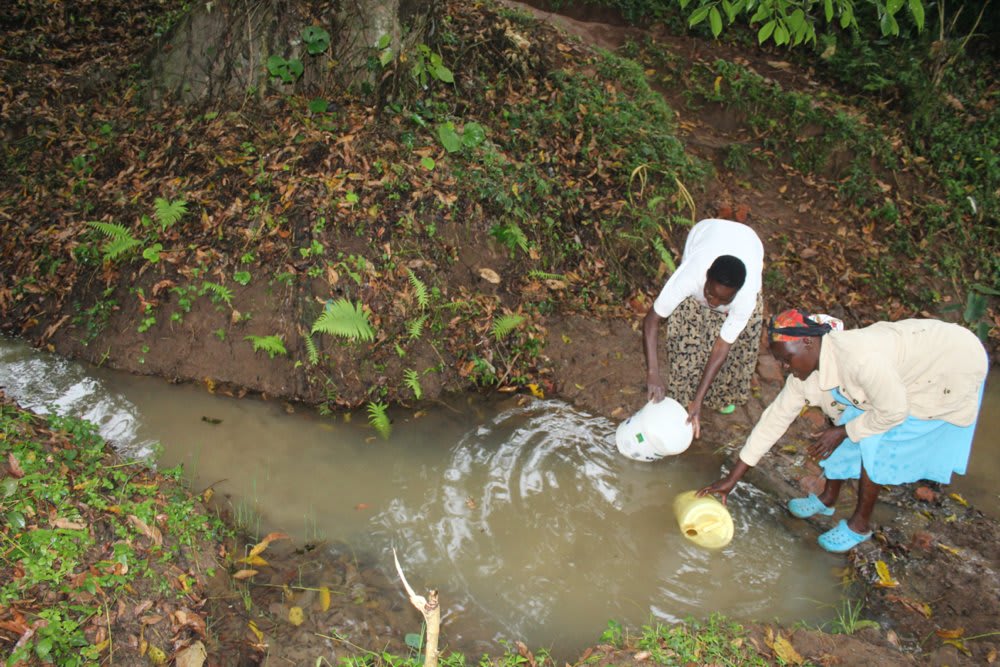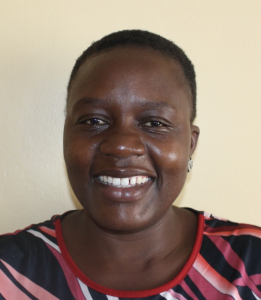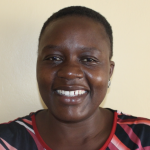"We have really suffered, especially considering during the rainy season, our water gets contaminated and gets filled up with debris. This has long been a cause of diarrhea, especially amongst the children," said Rophine Wekoye, a 46-year-old farmer and mother in Shianda.
"Whenever it rains, accessing the spring becomes difficult as the area becomes slippery. We also have a fish pond downstream, and whenever the water gets contaminated, we sometimes lose our fish due to deaths. This leads to reduced productivity, hence immense losses."
The spring Rophine refers to is Mwinami Spring, where 210 people in Shianda go for their daily water needs. But the spring is in abysmal shape and looks like a shallow muddy puddle at best.

To fetch water at the spring, community members must submerge their entire jerrycan directly into the water. This brings into the water any dirt or bacteria on the container or people's hands. Because the area is slick with mud, sometimes their feet slide in as well, or they are forced to step into the water to reach a deep enough place to submerge their jerrycan.
Since the spring water gets churned up with the mud and rotten leaves at the bottom whenever several people fetch it, many people resolve to come to the spring as early as 5:00 am to fetch the cleanest water possible. Those who delay going to the spring will have their day drag on as they wait in long lines. Consequently, they will also be late in making breakfast for their families and going to their farms or other jobs.
During the day, a few more trips are made to the spring to get water for watering the animals, doing the dishes, bathing, cooking dinner, and of course, drinking. Though some families have installed rain tanks in their homes to supplement the spring water during the rainy season, they are completely dependent on Mwinami Spring for water during the dry season. Crowding due to the tedious process at the spring gets worse.
But regardless of the time of day, the spring water is always contaminated. Surface runoff from the rains carries soil, farm chemicals, and animal waste, among other toxins. Dogs and other animals drink directly from the same pool of water community members have to dunk their jerrycans into. The rate of water-related diseases, as Rohpine noted, is high.
Access is the other major challenge at Mwinami Spring.
"Our spring has always been dangerous and risky, especially whenever it rains. It becomes slippery and very dangerous, especially to us children," said Mitchell, a primary school-aged girl.
Life in Shianda
The area around this community is beautiful and green. As you enter Shianda, you are met with a green vegetation cover of sugarcane, bananas, nappier grass, and forests. Houses are both semi-permanent and permanent. The road off of the Kakamega-Webuye Highway to Mwinami Spring is made of packed gravel and clay. There is a small forest on one side.
Shianda is an agricultural zone. Sugarcane farming as a cash crop dominates the area. Fish farming is also done purely for business, and a majority of the community members are fish farmers. On the other hand, brick making is also a common enterprise here, and many earn their livelihoods from these activities. Finally, several people here are dairy farmers. They earn a living by selling milk and even cows whenever the number in their herds increase.
Shianda borders the Malava Forest on the right side. Monkeys from the forest are notorious for coming down to Shianda to search for food. Whenever the monkeys cannot find food, they get agitated and wreak havoc on the community's farms, uprooting all of their nappier grass or anything grown in the fields, ruining it. The Shianda community also has a sacred forest that they use for traditional celebrations.
What We Can Do:
Spring Protection
Protecting the spring will help provide access to cleaner and safer water and reduce the time people have to spend to fetch it. Construction will keep surface runoff and other contaminants out of the water. With the community’s high involvement in the process, there should be a good sense of responsibility and ownership for the new clean water source.
Fetching water is a task predominantly carried out by women and young girls. Therefore, protecting the spring and offering training and support will help empower the community's female members by freeing up more of their time and energy to engage and invest in income-generating activities and education.
Training on Health, Hygiene, COVID-19, and More
To hold training during the pandemic, we work closely with both community leaders and the local government to approve small groups to attend training. We ask community leaders to invite a select yet representative group of people to attend training, which will then act as ambassadors to the rest of the community to share what they learn. We also communicate our expectations of physical distancing and wearing masks for all who choose to attend.
The training will focus on improved hygiene, health, and sanitation habits in this community. We will also have a dedicated session on COVID-19 symptoms, transmission routes, and prevention best practices.
With the community’s input, we will identify key leverage points to alter their practices at the personal, household, and community levels to affect change. This training will help ensure participants have the knowledge they need about healthy practices and their importance to make the most of their water points as soon as the water is flowing.
Our team of facilitators will use a variety of methods to train community members. These methods include participatory hygiene and sanitation transformation, asset-based community development, group discussions, handouts, and demonstrations in the spring.
One of the most important issues we plan to cover is handling, storing, and treating water. Having a clean water source will be extremely helpful, but it is useless if water gets contaminated by the time it is consumed. The community and we strongly believe that all of these components will work together to improve living standards here, which will help to unlock the potential for these community members to live better, healthier lives.
We will then conduct a small series of follow-up training before transitioning to our regularly scheduled support visits throughout the year.
Training will result in forming a water user committee, elected by their peers, to oversee the spring's operations and maintenance. The committee will enforce proper behavior around the spring and delegate tasks that will help preserve the site, such as building a fence and digging proper drainage channels. The fence will keep out destructive animals and unwanted waste, and the drainage will keep the area’s mosquito population at a minimum.

 Protected Spring
Protected Spring
 Rehabilitation Project
Rehabilitation Project







































